Long-Term Scenarios of Indonesia Power Sector to Achieve Nationally Determined Contribution (NDC) 2060
Abstract
1. Introduction
2. Literature Review
2.1. Indonesia’s Power Sector
2.2. Previous Research
3. Methodology
3.1. LEAP Software
3.2. Simulation Scenarios and Input Data
4. Scenario Results
4.1. Demand Projection
4.2. Power Generation Expansion
4.2.1. Reference Scenario (REF)
4.2.2. Conservative Scenario (CON)
4.2.3. Moderate Scenario (MOD)
4.2.4. Progressive Scenario (PRO)
4.2.5. Advanced Scenario (ADV)
4.3. Investment Cost
4.4. Results Check with Previous Research
5. Conclusions
Author Contributions
Funding
Data Availability Statement
Conflicts of Interest
Appendix A. LEAP Model Parameter
| Input Data | Value | Source |
|---|---|---|
| Electricity demand growth 2022–2060 | 4.5% | [6,7] |
| Transmission and distribution losses | 6–9.4% | [6] |
| Reserve margin | 35% | [6] |
| Discount Rate | 12% | [29] |
| Inflation Rate | 6% | [30] |
| Existing Capacity and Retirement | varies | [5] |
| Load Curve | Figure A1 | [31] |
| Solar availability curve | Figure A2 | [32] |
| Wind availability curve | Figure A3 | [33] |
| Time Slice | 336 |
| Branch | Lifetime [34,35] | Efficiency [35,36] | Maximum Availability [37,38,39] | Capacity Credit [35] | Capital Cost [35,36,37,38] | Fixed O/M Cost [35,36,37,38] | Variable O/M Cost [35,36,37,38] |
|---|---|---|---|---|---|---|---|
| (years) | (%) | (%) | (%) | (USD/MW) | (USD/MW) | (USD/MWh) | |
| Hydro | 50 | 100 | 36 | 51 | 1450–2080 | 37.7 | 0.65 |
| Geothermal | 30 | 15 | 90 | 100 | 2497–4000 | 50 | 0.25 |
| Biomass | 25 | 31 | 80 | 100 | 2000–2300 | 47.6 | 3 |
| Solar | 25 | 100 | [7] | 22 | 1190–2000 | 14.4 | 0 |
| Wind | 27 | 100 | [7] | 35 | 1500–2550 | 60 | 0 |
| Natural Gas | 30 | 56 | 85 | 100 | 690–1200 | 23.5 | 2.3 |
| Coal | 30 | 42 | 80 | 100 | 1520–1900 | 56.6 | 0.11 |
| Diesel | 30 | 45 | 95 | 100 | 800 | 8 | 6.4 |
| Li-ion BESS | 20 | 94 | 17 | 22 | 2002 | 7.6 | 2.3 |
| Nuclear | 40 | 33 | 85 | 100 | 6000 | 164 | 8.6 |
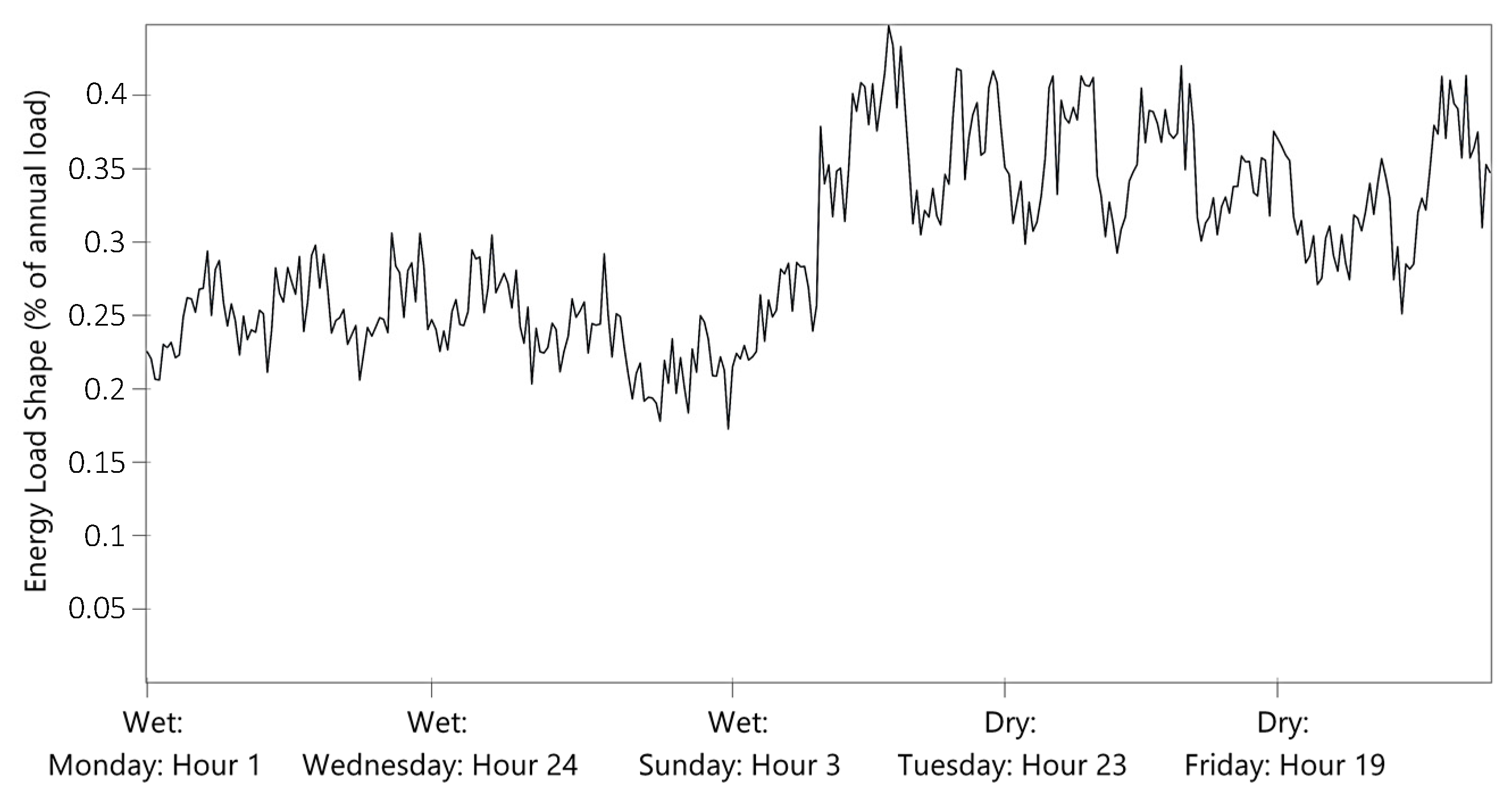
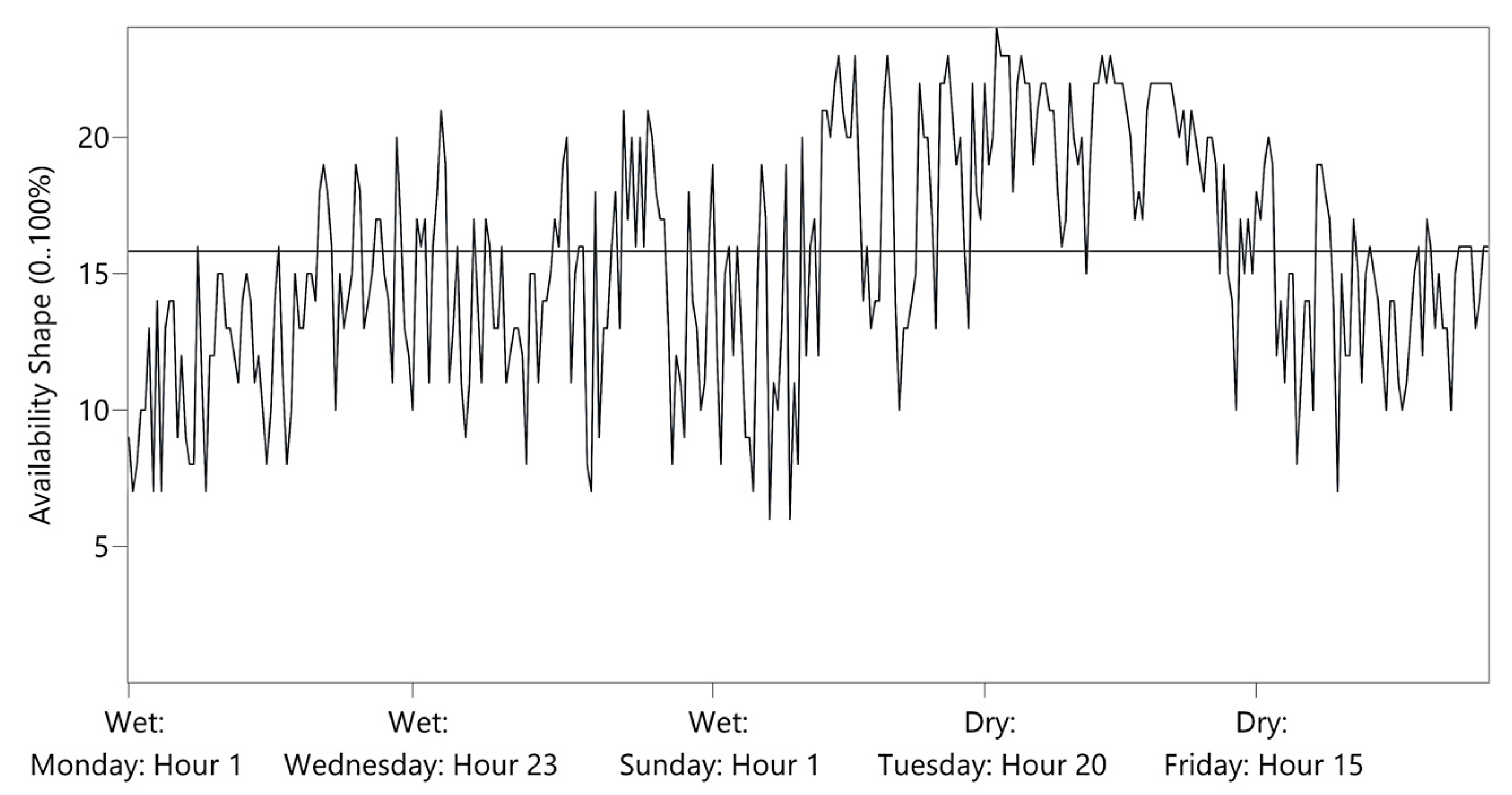
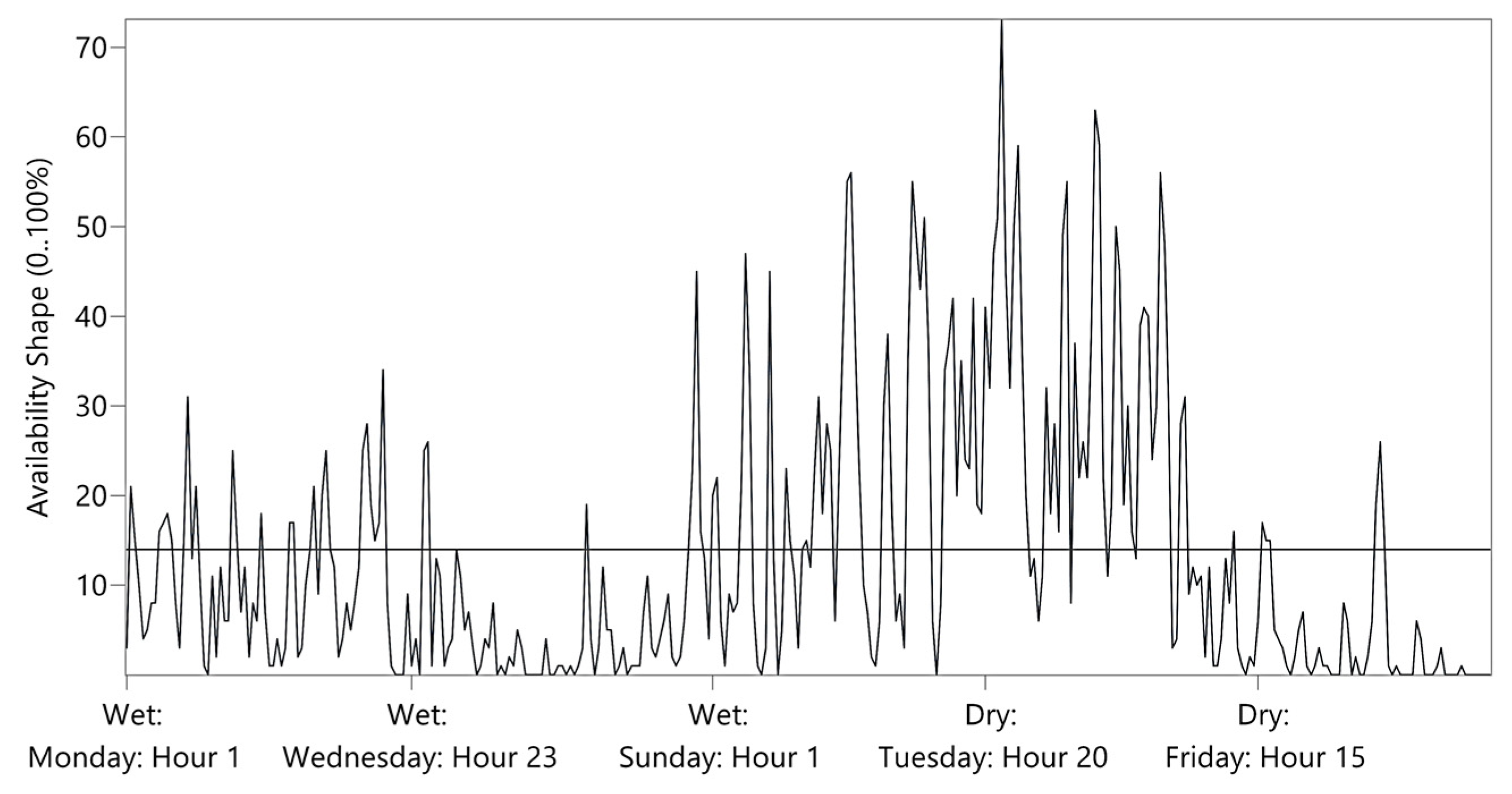
References
- Ministry of Environment and Forestry. Enhanced Nationally Determined Contribution Republic of Indonesia 2022; Ministry of Environment and Forestry: Jakarta, Indonesia, 2022. [Google Scholar]
- Ardiansyah, H.; Ekadewi, P.; Silalahi, D.F.; Gunawan, D.; Wahyuni, E.; Dipayana, G.F.; Hardhi, M.; Winofa, N.C.; Ramadhan, R.A.; Hidayat, T. Indonesia Post-Pandemic Outlook: Strategy towards Net-Zero Emissions by 2060 from the Renewables and Carbon-Neutral Energy Perspectives; Penerbit BRIN: Jakarta, Indonesia, 2022. [Google Scholar] [CrossRef]
- IEA Indonesia’s Push to Reach Net Zero Emissions Can Help Power a New Phase in Its Economic Development–News–IEA. Available online: https://www.iea.org/news/indonesia-s-push-to-reach-net-zero-emissions-can-help-power-a-new-phase-in-its-economic-development (accessed on 7 October 2022).
- Iqbal Ilham Indonesia’s Net Zero Emissions: A Roadmap for Clean, Affordable and Secure Energy—IESR. Available online: https://iesr.or.id/en/indonesias-net-zero-emissions-a-roadmap-for-clean-affordable-and-secure-energy (accessed on 9 September 2022).
- PT PLN (Persero). STATISTIK PLN 2021; PT PLN (Persero): Jakarta, Indonesia, 2022. [Google Scholar]
- PT PLN (Persero). Electricity Business Plan PT PLN (Persero) 2021–2030; PT PLN (Persero): Jakarta, Indonesia, 2022. [Google Scholar]
- IEA. An Energy Sector Roadmap to Net Zero Emissions in Indonesia; International Energy Agency: Paris, France, 2022. [Google Scholar]
- PT PLN (Persero) A 35,000 MW Power Plant Program for Indonesia; PT PLN (Persero): Jakarta, Indonesia, 2015.
- Deloitte. 35,000 MW: A Light for the Nation; Deloitte: Jakarta, Indonesia, 2016. [Google Scholar]
- Suharsono, A.; Lontoh, L. Indonesia’s Energy Policy Briefing: July 2020; International Institute for Sustainable Development: Winnipeg, MB, Canada, 2020. [Google Scholar]
- Hans Nicholas Jong Indonesia Says No New Coal Plants from 2023 (after the Next 100 or So). Available online: https://news.mongabay.com/2021/05/indonesia-says-no-new-coal-plants-from-2023-after-the-next-100-or-so/ (accessed on 14 September 2022).
- PwC Indonesia Biomass Co-Firing in Coal-Fired Power Plants: PLN’s Ambition to Drive Green Energy. Available online: https://www.pwc.com/id/en/media-centre/infrastructure-news/may-2021/biomass-co-firing-in-coal-fired-power-plants-pln-s-ambition-to-drive-green-energy.html (accessed on 11 September 2022).
- International Trade Administration Indonesia—Energy. Available online: https://www.trade.gov/country-commercial-guides/indonesia-energy (accessed on 18 September 2022).
- Nathan Lee, F.F.-E.; Ricardo Oliveira, B.R.; Thomas Bowen, J.K. Exploring Renewable Energy Opportunities in Select Southeast Asian Countries: A Geospatial Analysis of the Levelized Cost of Energy of Utility-Scale Wind and Solar Photovoltaics; National Renewable Energy Lab. (NREL): Golden, CO, USA, 2020. [Google Scholar]
- IEA. Enhancing Indonesia’s Power System Pathways to Meet the Renewables Targets in 2025 and Beyond; International Energy Agency: Paris, France, 2022. [Google Scholar]
- Sambodo, M.T.; Yuliana, C.I.; Hidayat, S.; Novandra, R.; Handoyo, F.W.; Farandy, A.R.; Inayah, I.; Yuniarti, P.I. Breaking Barriers to Low-Carbon Development in Indonesia: Deployment of Renewable Energy. Heliyon 2022, 8, e09304. [Google Scholar] [CrossRef] [PubMed]
- Zhong, S.; Su, B.; Lin, X.; Ng, T.S. Moving towards a Net-Zero Emissions Economy: The Case of Indonesia. Available online: https://ssrn.com/abstract=4295163 (accessed on 6 December 2022).
- Kanugrahan, S.P.; Hakam, D.F.; Nugraha, H. Techno-Economic Analysis of Indonesia Power Generation Expansion to Achieve Economic Sustainability and Net Zero Carbon 2050. Sustainability 2022, 14, 9038. [Google Scholar] [CrossRef]
- Kanugrahan, S.P.; Hakam, D.F. Technoeconomic Analysis of Indonesia Generation Expansion to Achieve Energy and Economic Sustainability. In Proceedings of the 1st IAEE Online Conference, Online, 7–9 June 2021. [Google Scholar]
- Kanugrahan, S.P.; Hakam, D.F. Unlocking Indonesia Potential Resources to Achieve Net Zero Emission 2060: Generation Expansion Planning Using LEAP. In Proceedings of the 17th IAEE European Energy Conference, Athens, Greece, 21–24 September 2022. [Google Scholar]
- Handayani, K.; Anugrah, P.; Goembira, F.; Overland, I.; Suryadi, B.; Swandaru, A. Moving beyond the NDCs: ASEAN Pathways to a Net-Zero Emissions Power Sector in 2050. Appl. Energy 2022, 311, 118580. [Google Scholar] [CrossRef]
- Handayani, K.; Krozer, Y.; Filatova, T. From Fossil Fuels to Renewables: An Analysis of Long-Term Scenarios Considering Technological Learning. Energy Policy 2019, 127, 134–146. [Google Scholar] [CrossRef]
- Handayani, K.; Filatova, T.; Krozer, Y.; Anugrah, P. Seeking for a Climate Change Mitigation and Adaptation Nexus: Analysis of a Long-Term Power System Expansion. Appl. Energy 2020, 262, 114485. [Google Scholar] [CrossRef]
- Sani, L.; Khatiwada, D.; Harahap, F.; Silveira, S. Decarbonization Pathways for the Power Sector in Sumatra, Indonesia. Renew. Sustain. Energy Rev. 2021, 150, 111507. [Google Scholar] [CrossRef]
- Heaps, C. LEAP: The Low Emissions Analysis Platform. 2022. Available online: https://www.sei.org/projects-and-tools/tools/leap-long-range-energy-alternatives-planning-system/ (accessed on 20 June 2022).
- Ayuketah, Y.; Gyamfi, S.; Diawuo, F.A.; Dagoumas, A.S. Assessment of Low-Carbon Energy Transitions Policies for the Energy Demand Sector of Cameroon. Energy Sustain. Dev. 2023, 72, 252–264. [Google Scholar] [CrossRef]
- Zhou, J.; He, Y.; Lyu, Y.; Wang, K.; Che, Y.; Wang, X. Long-Term Electricity Forecasting for the Industrial Sector in Western China under the Carbon Peaking and Carbon Neutral Targets. Energy Sustain. Dev. 2023, 73, 174–187. [Google Scholar] [CrossRef]
- United Nations; Department of Economic and Social Affairs; Population Division. World Population Prospects 2022, Online Edition; United Nations: New York, USA, 2022. [Google Scholar]
- IESR. Levelized Cost of Electricity in Indonesia; IESR: Jakarta, Indonesia, 2019. [Google Scholar]
- The World Bank Inflation, GDP Deflator (Annual %)—Indonesia|Data. Available online: https://data.worldbank.org/indicator/NY.GDP.DEFL.KD.ZG?locations=ID (accessed on 28 September 2022).
- PT PLN (Persero). Indonesia Load Curve; PT PLN (Persero): Jakarta, Indonesia, 2021. [Google Scholar]
- Pfenninger, S.; Staffell, I. Long-Term Patterns of European PV Output Using 30 Years of Validated Hourly Reanalysis and Satellite Data. Energy 2016, 114, 1251–1265. [Google Scholar] [CrossRef]
- Staffell, I.; Pfenninger, S. Using Bias-Corrected Reanalysis to Simulate Current and Future Wind Power Output. Energy 2016, 114, 1224–1239. [Google Scholar] [CrossRef]
- Rothwell, G.; Rust, J. On the Optimal Lifetime of Nuclear Powe Plants. J. Bus. Econ. Stat. 1997, 15, 195–208. [Google Scholar] [CrossRef]
- MEMR; Danish Energy Agency. Technology Data for the Indonesian Power Sector Catalogue for Generation and Storage of Electricity; Ministry of Energy and Mineral Resources: Jakarta, Indonesia, 2021; Available online: https://ens.dk/sites/ens.dk/files/Globalcooperation/technology_data_for_the_indonesian_power_sector_-_final.pdf (accessed on 10 October 2022).
- IEA. World Energy Outlook 2020; IEA: Paris, France, 2020. [Google Scholar]
- DEN. Indonesia Energy Outlook; Dewan Energi Nasional: Jakarta, Indonesia, 2019. [Google Scholar]
- IEA. Projected Costs of Generating Electricity 2015–Analysis–IEA; International Energy Agency: Paris, France, 2015. [Google Scholar]
- Mongird, K.; Viswanathan, V.V.; Balducci, P.J.; Alam, M.J.E.; Fotedar, V.; Koritarov, V.S.; Hadjerioua, B. Energy Storage Technology and Cost Characterization Report; Pacific Northwest National Lab. (PNNL): Richland, WA, USA, 2019. [Google Scholar]
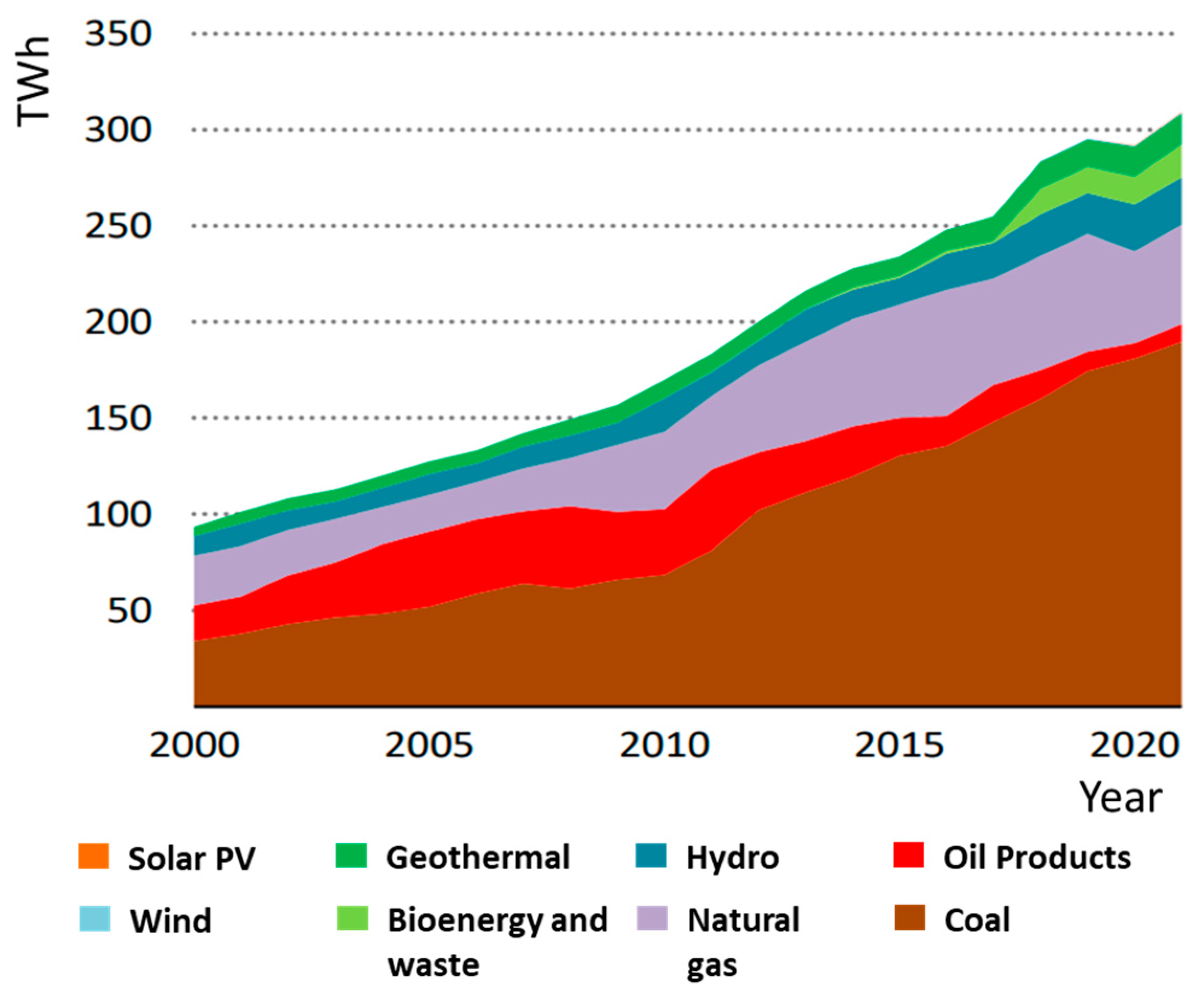
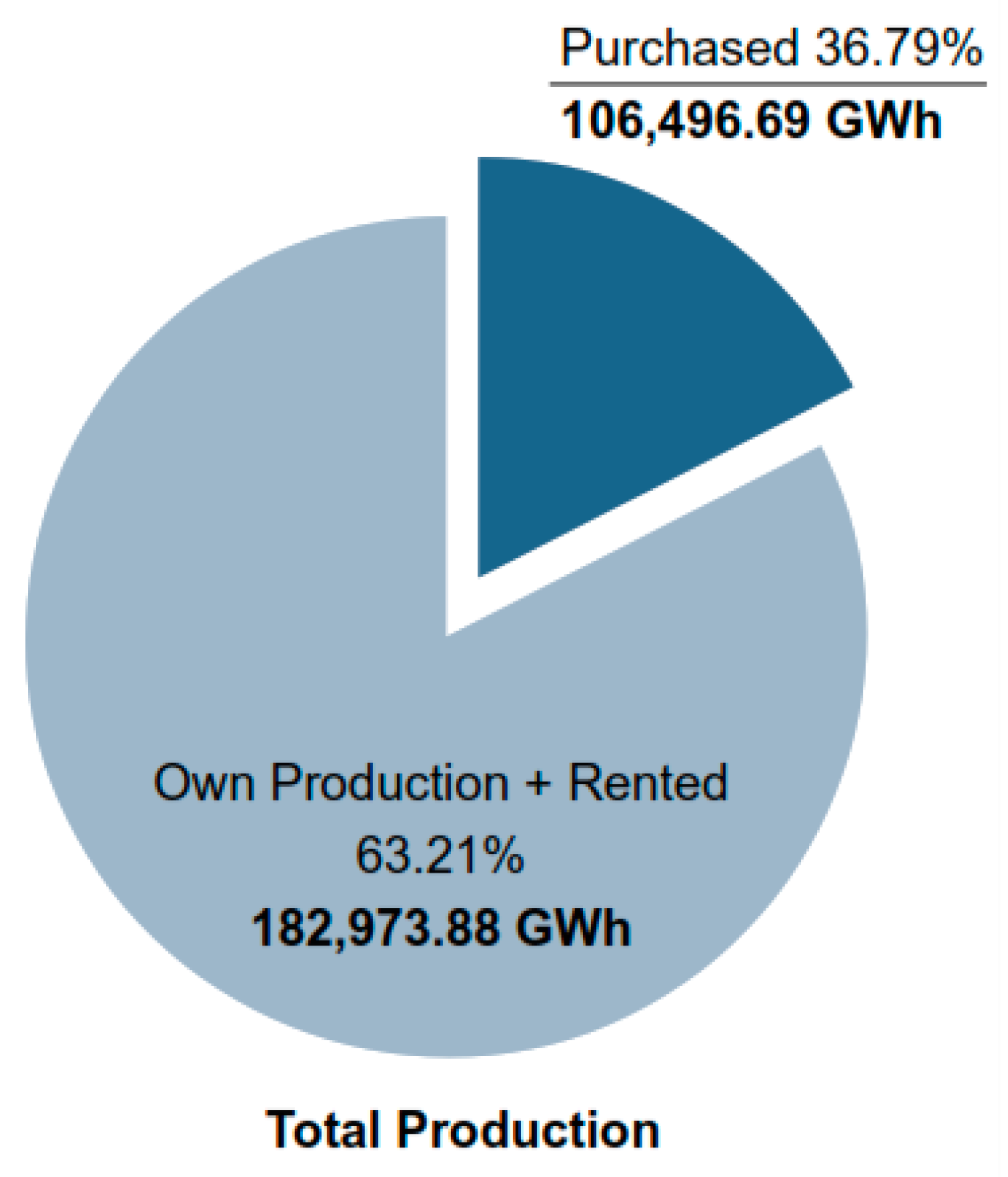
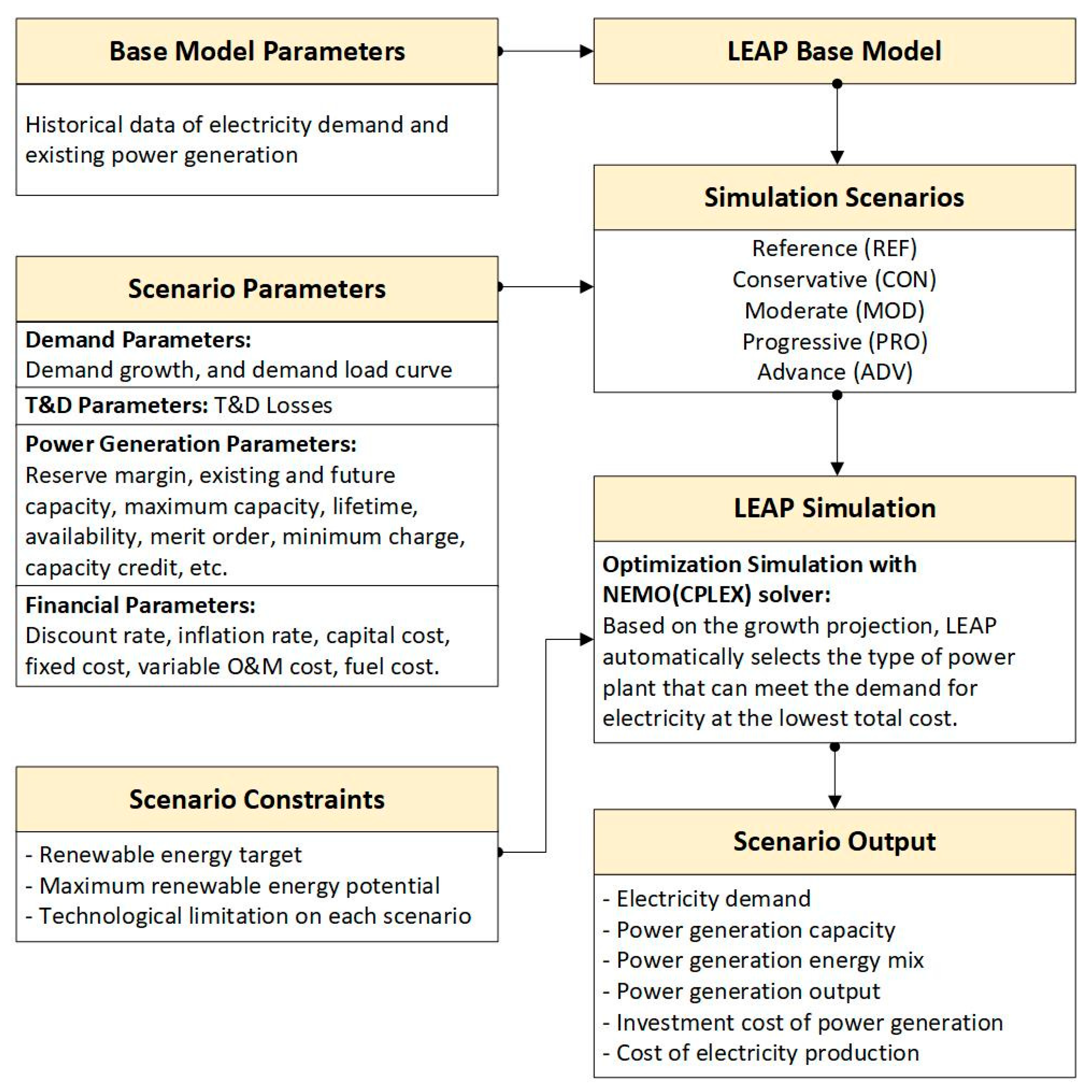
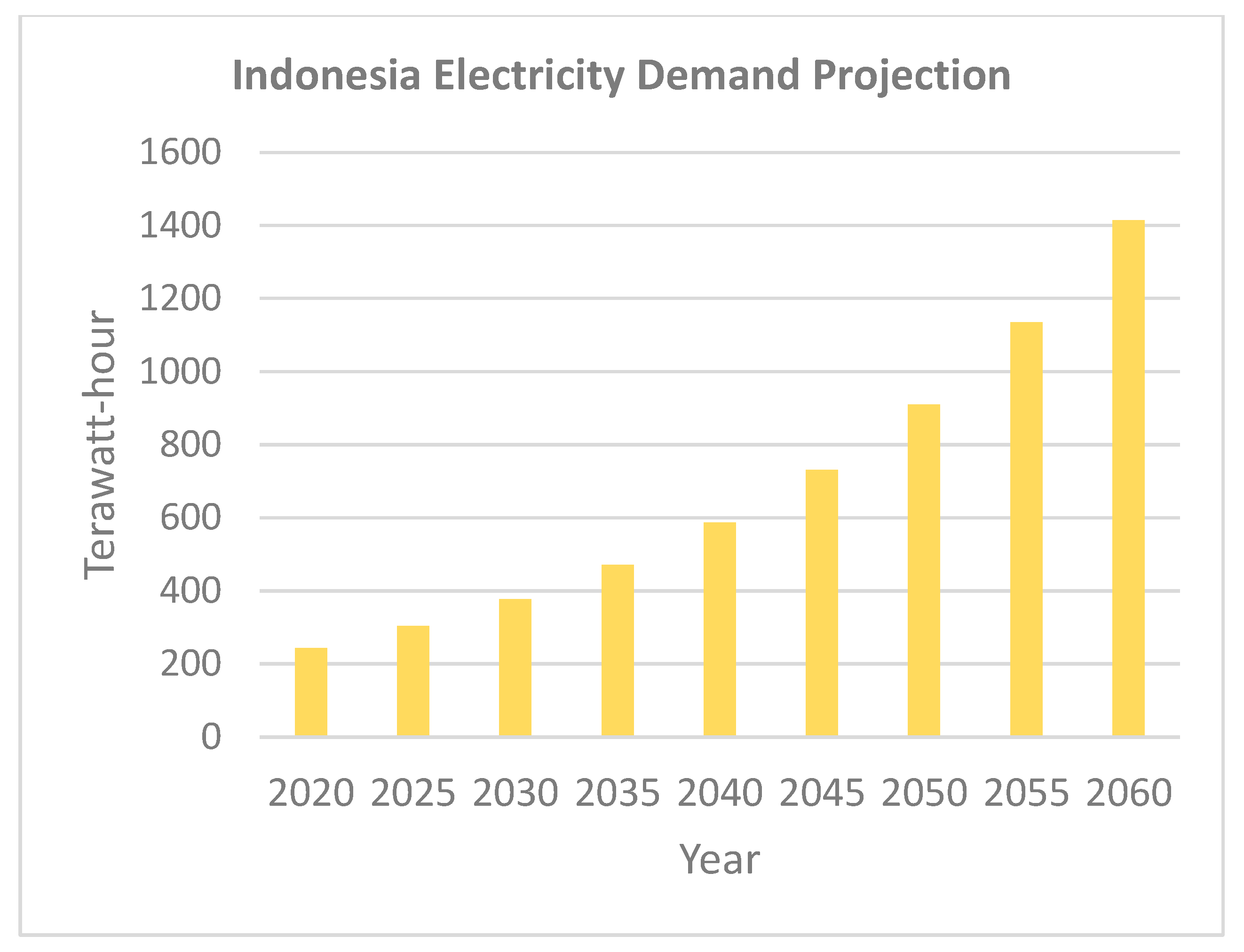
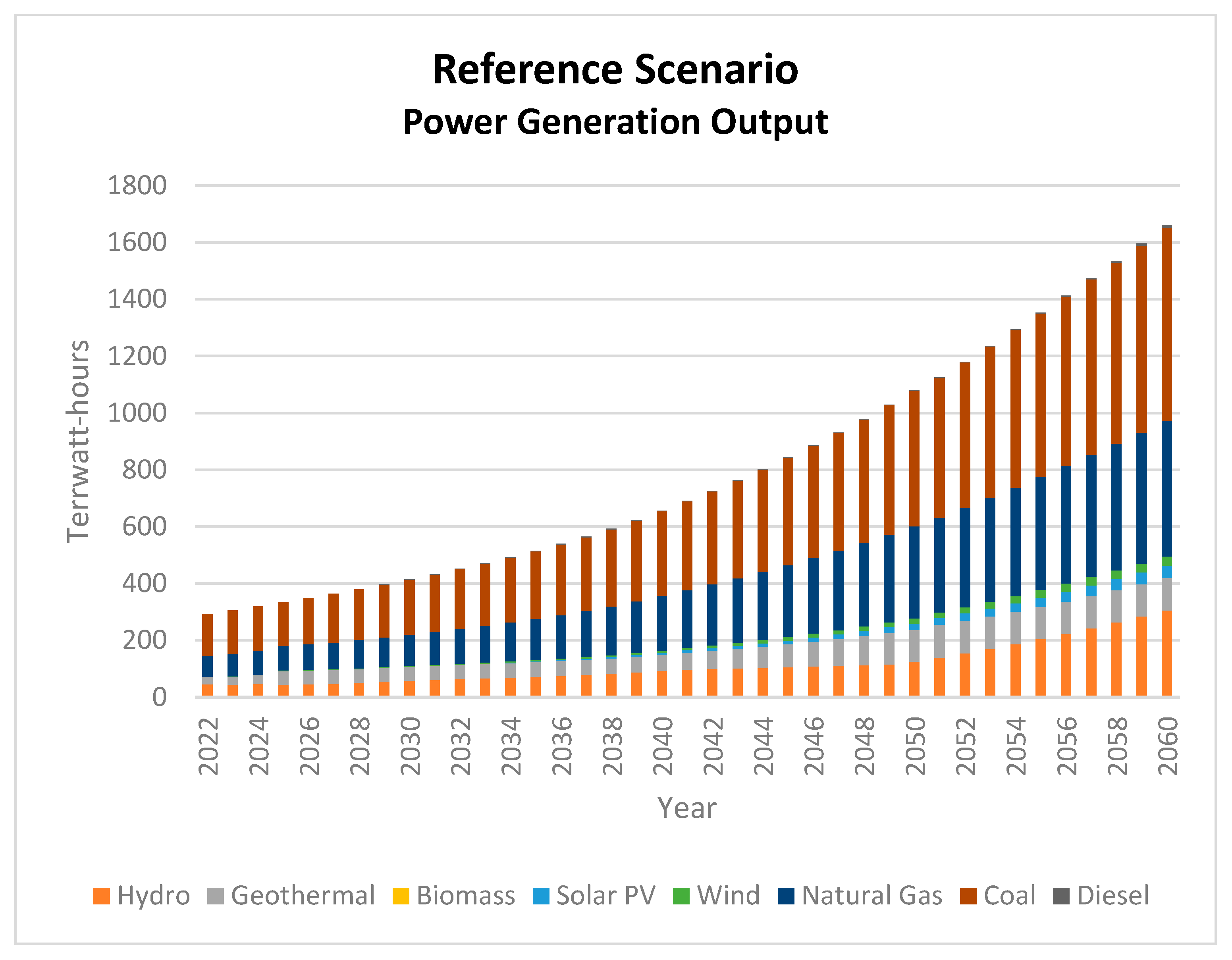
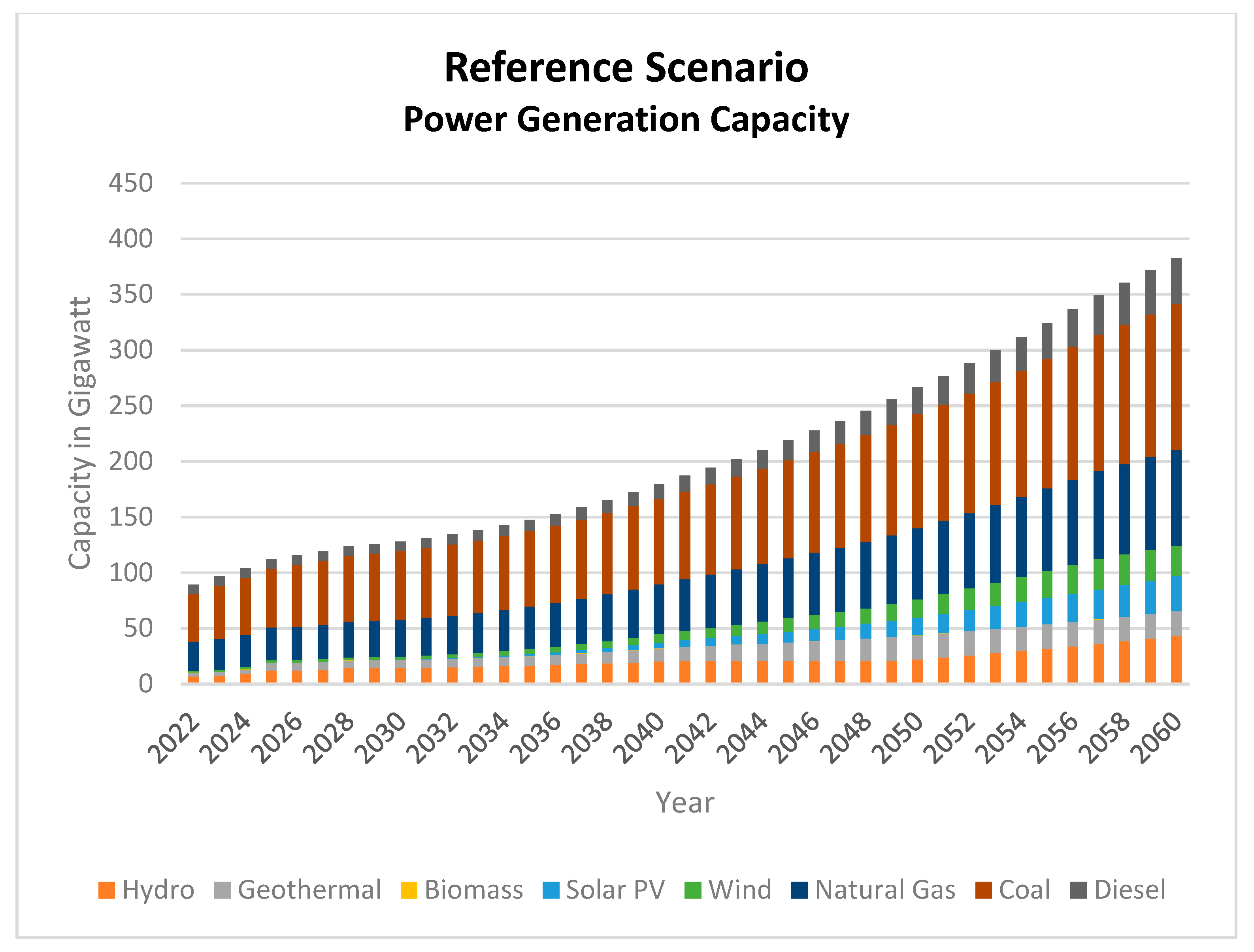
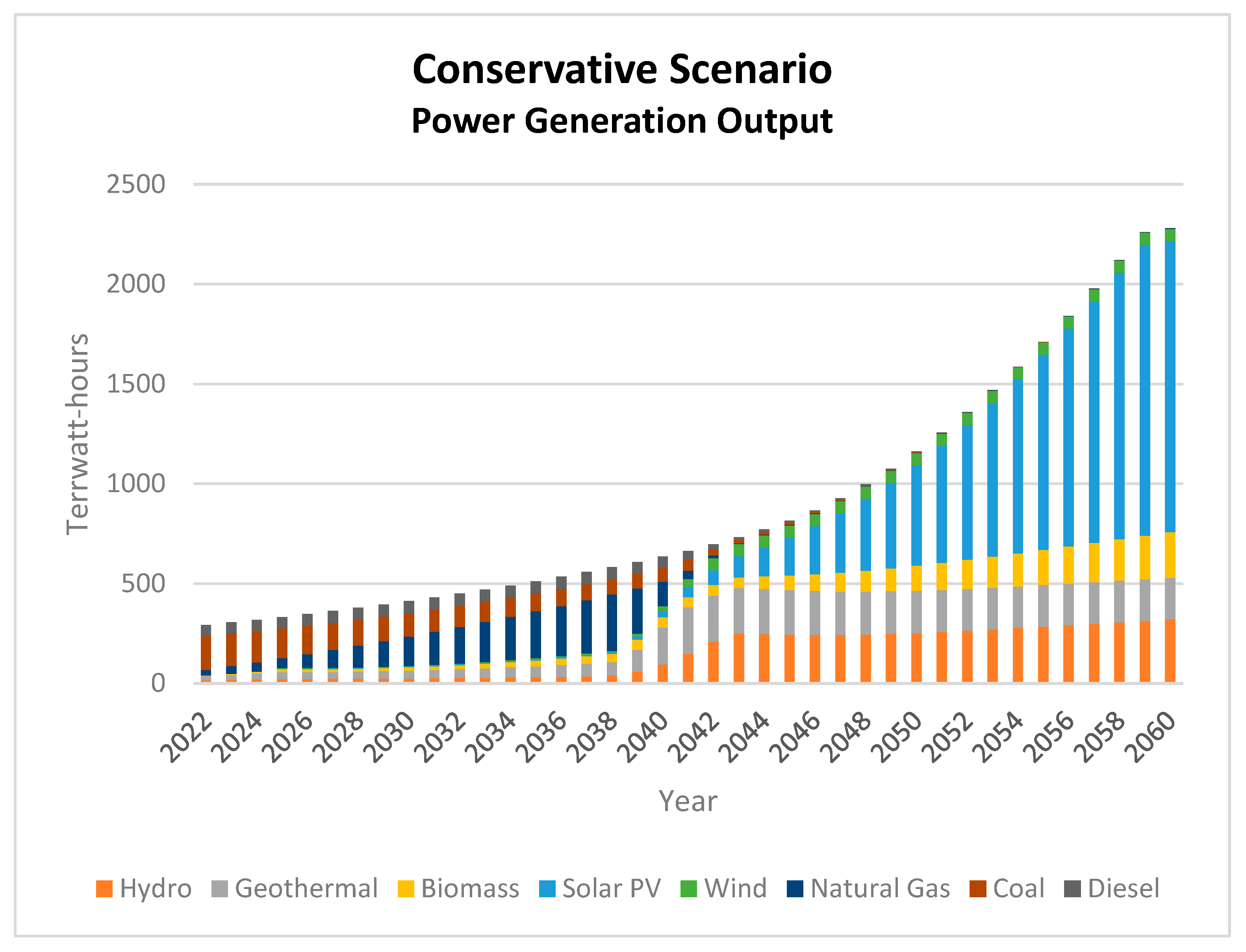
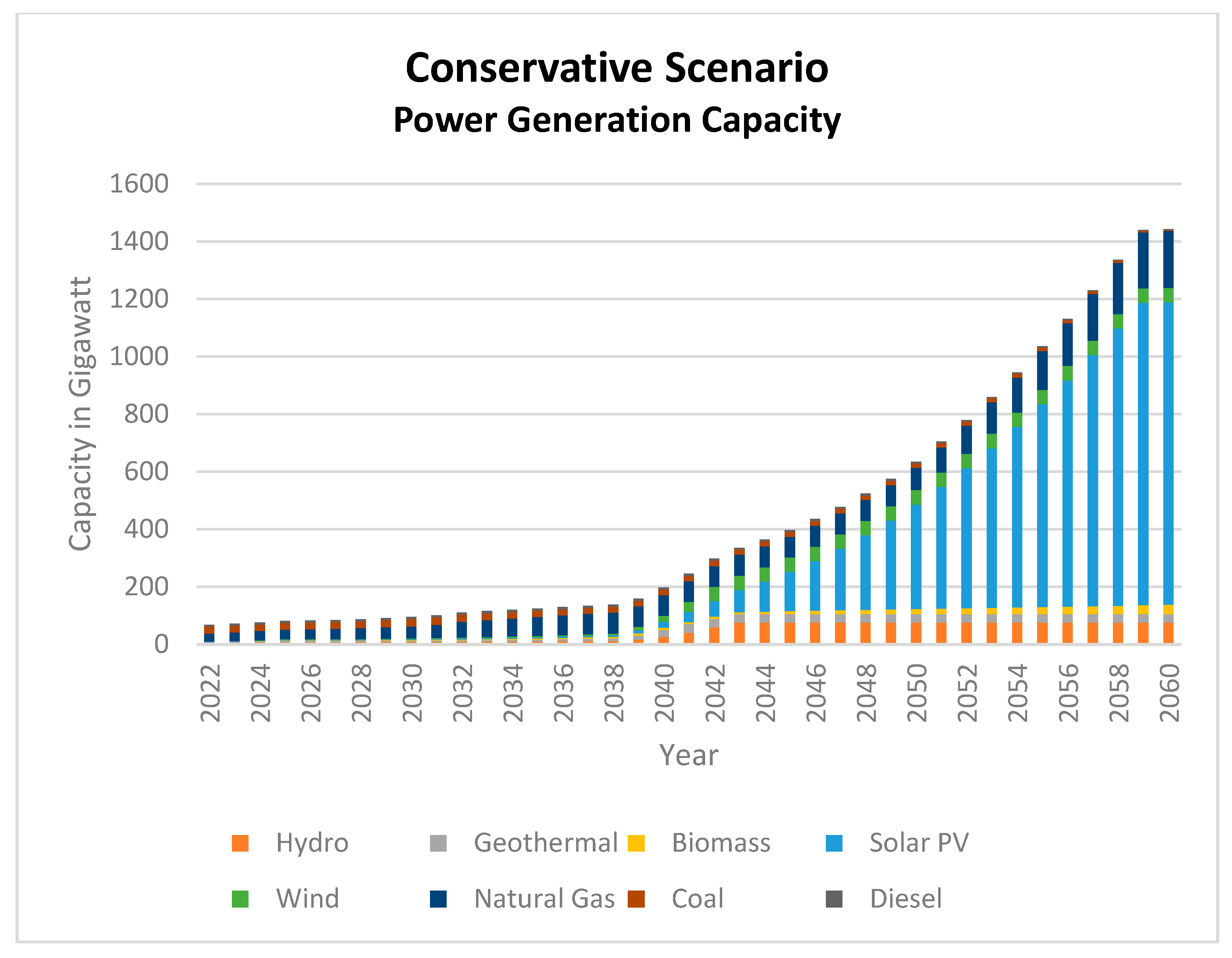


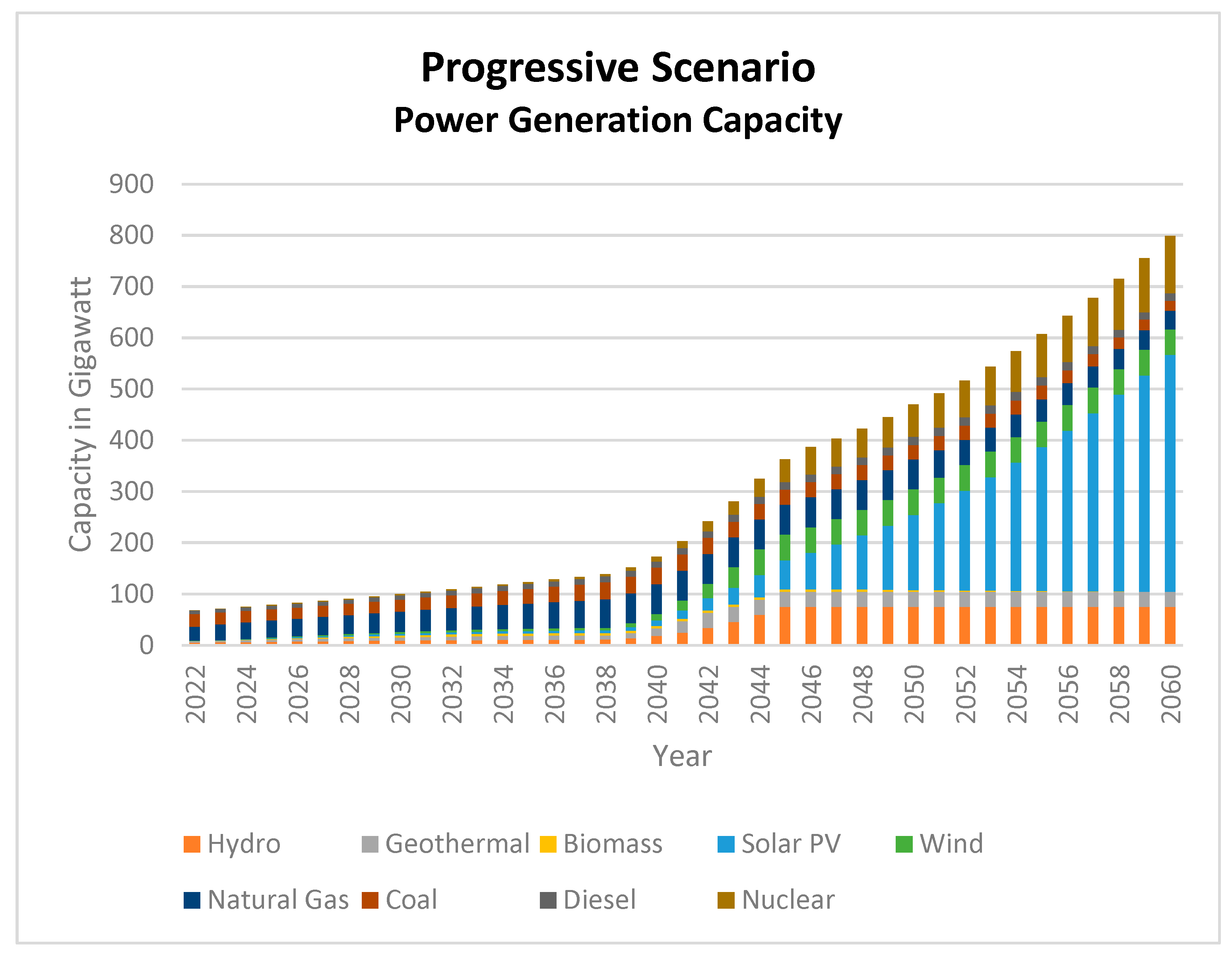
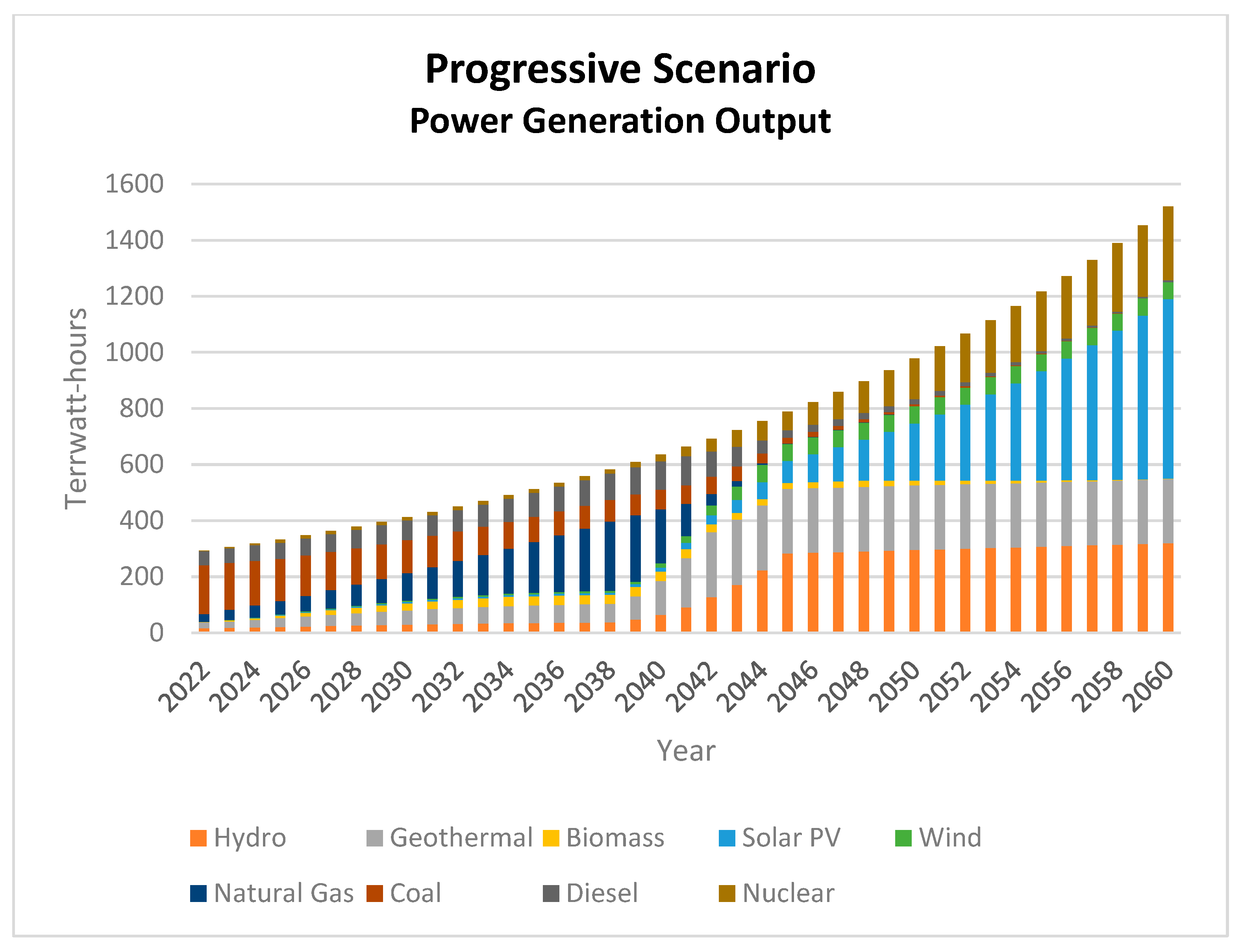
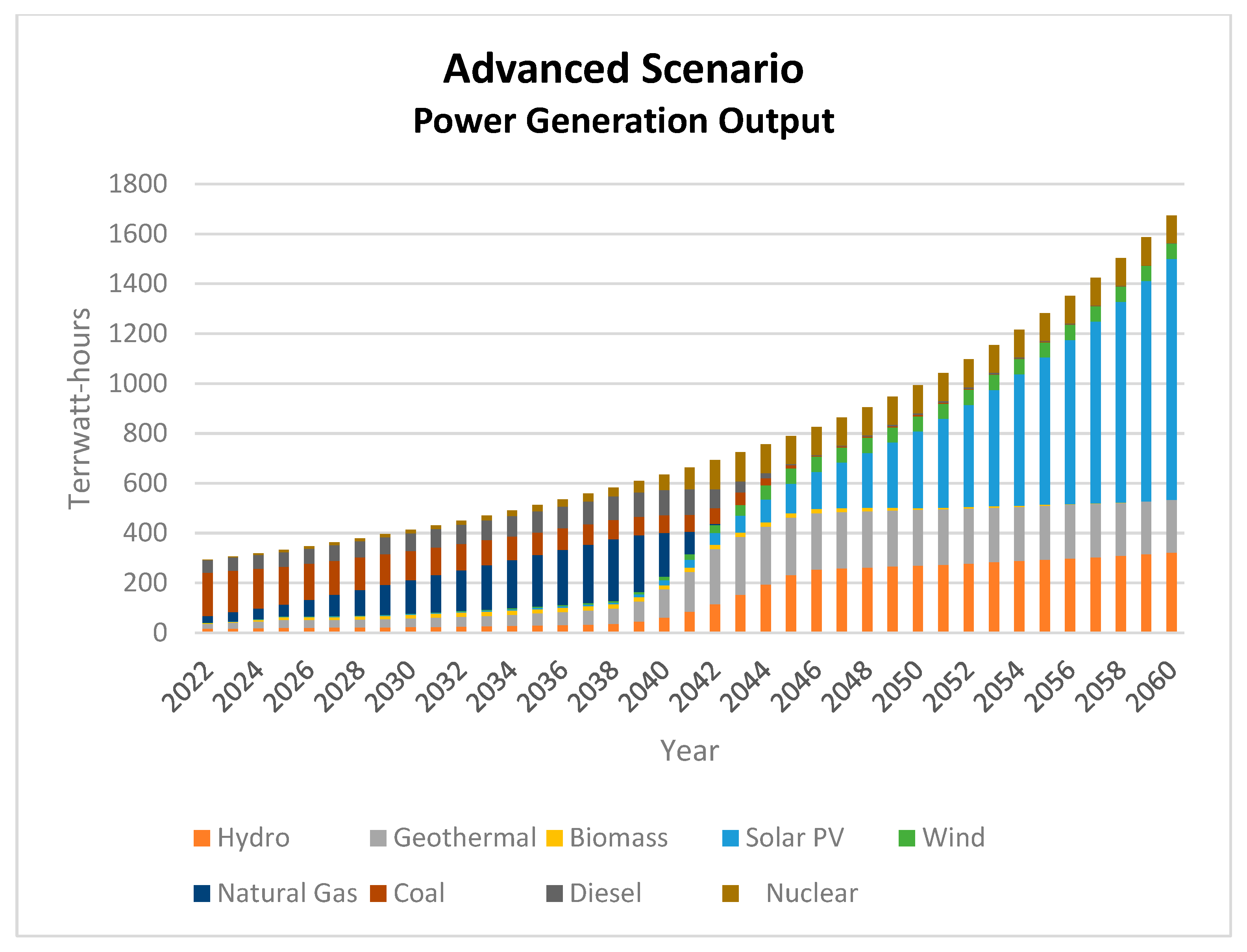
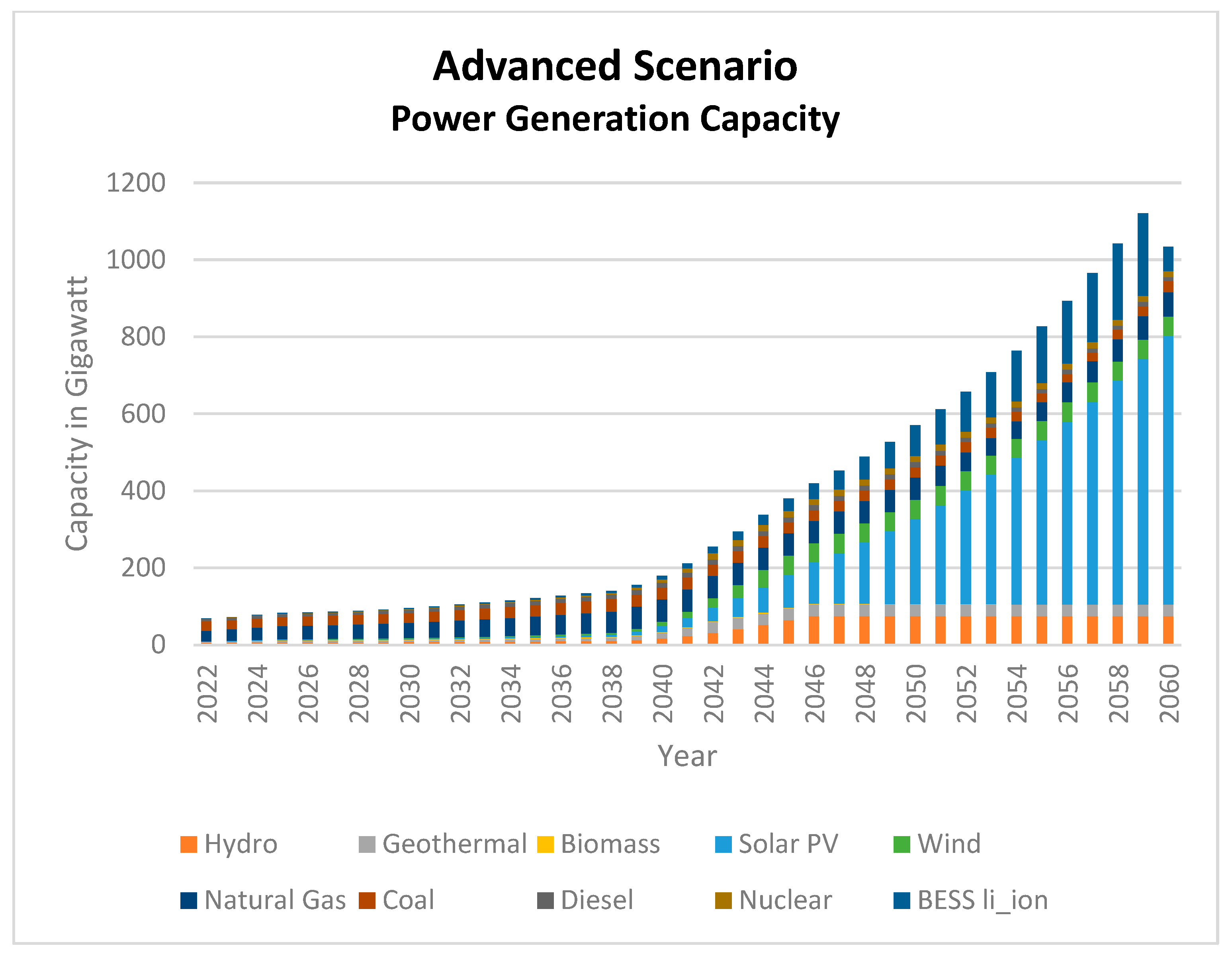
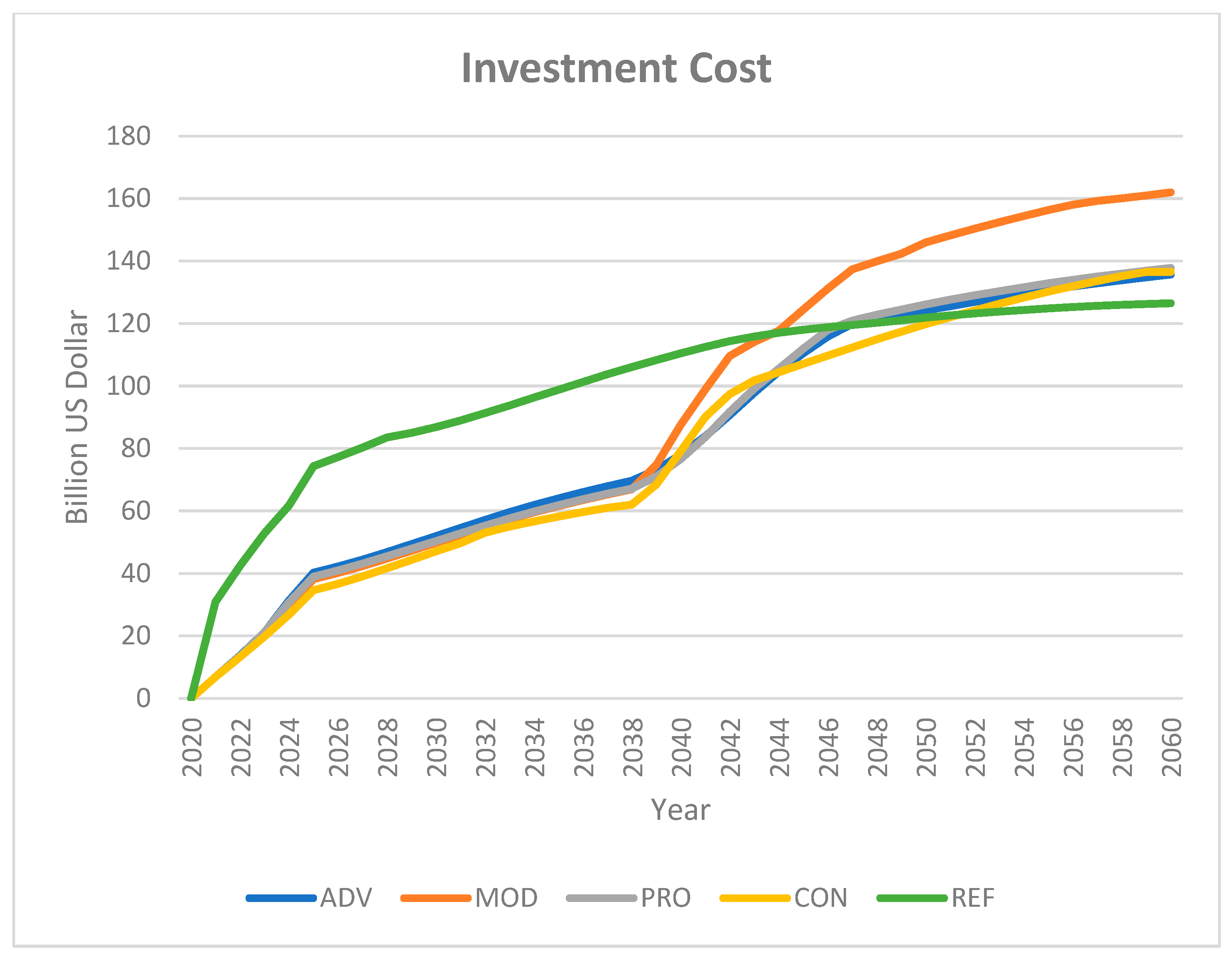
| Energy Source | Potential Capacity (GW) | Installed Capacity (GW) | Percentage |
|---|---|---|---|
| Hydro | 75.1 | 4.8 | 6.43% |
| Geothermal | 29.5 | 1.4 | 4.87% |
| Biomass | 32.7 | 1.7 | 5.12% |
| Solar Energy | 1052.0 | 0.1 | 0.01% |
| Wind | 50.0 | 0.003 | 0.01% |
| Ocean | 18.0 | 0.000 | 0.00% |
| Total | 1257.3 | 8.02 | 0.64% |
| Research | Time Period | Sector | Area | Result | Scenario | |
|---|---|---|---|---|---|---|
| Energy Mix | GHG | |||||
| Zhong et al. [17] | 2020–2060 | Power | Indonesia | ✓ | ✓ | Business as Usual, National Plan, Renewable Enhancement, Zero Carbon |
| Kanugrahan et al. [18] | 2020–2050 | Power | Indonesia | ✓ | Business as Usual, Cost Optimization, National Plan, Zero Carbon | |
| Handayani et al. [21] | 2020–2050 | Power | ASEAN Nations | ✓ | ✓ | Business as Usual, National Plan, Zero Carbon |
| Sani et al. [24] | 2019–2028 | Power | Sumatra Island | ✓ | ✓ | Business as Usual, National Plan, Carbon Reduction 19%, Carbon Reduction 24% |
| IEA [7] | 2020–2060 | Power | Indonesia | ✓ | ✓ | National Plan, Zero Carbon |
| This Research | 2022–2060 | Power | Indonesia | ✓ | Business as Usual, Zero Carbon with various tech | |
| Total Energy Production (TWh) | Year | |||
|---|---|---|---|---|
| 2030 | 2040 | 2050 | 2060 | |
| 413.22 | 655.80 | 1079.35 | 1661.67 | |
| Hydro | 14.08% | 14.19% | 11.57% | 18.34% |
| Geothermal | 11.74% | 8.71% | 10.37% | 6.93% |
| Biomass | 0.00% | 0.00% | 0.00% | 0.00% |
| Solar | 0.08% | 1.04% | 2.03% | 2.61% |
| Wind | 0.82% | 1.20% | 1.63% | 1.88% |
| Natural Gas | 26.54% | 29.14% | 30.12% | 28.67% |
| Coal | 46.67% | 45.41% | 44.14% | 40.95% |
| Diesel | 0.07% | 0.31% | 0.13% | 0.63% |
| Total Capacity (GW) | Year | |||
|---|---|---|---|---|
| 2030 | 2040 | 2050 | 2060 | |
| 127.80 | 179.53 | 266.47 | 382.55 | |
| Hydro | 14.47 | 20.32 | 22.00 | 43.48 |
| Geothermal | 7.04 | 11.73 | 21.56 | 21.86 |
| Biomass | 0.17 | 0.17 | 0.17 | 0.17 |
| Solar | 0.25 | 4.94 | 15.88 | 31.31 |
| Wind | 2.81 | 7.49 | 16.43 | 27.62 |
| Natural Gas | 33.31 | 44.93 | 64.06 | 85.63 |
| Coal | 61.30 | 76.80 | 102.30 | 131.40 |
| Diesel | 8.45 | 13.14 | 24.08 | 41.08 |
| Total Energy Production (TWh) | Year | |||
|---|---|---|---|---|
| 2030 | 2040 | 2050 | 2060 | |
| 412.75 | 635.09 | 1162.09 | 2280.51 | |
| Hydro | 6.08% | 15.04% | 21.76% | 14.13% |
| Geothermal | 9.51% | 29.09% | 18.21% | 9.10% |
| Biomass | 4.11% | 8.28% | 10.76% | 10.02% |
| Solar | 0.84% | 4.51% | 43.37% | 63.92% |
| Wind | 0.72% | 3.97% | 5.27% | 2.68% |
| Natural Gas | 35.70% | 19.25% | 0.15% | 0.11% |
| Coal | 28.40% | 11.01% | 0.26% | 0.02% |
| Diesel | 14.65% | 8.85% | 0.23% | 0.01% |
| Total Capacity (GW) | Year | |||
|---|---|---|---|---|
| 2030 | 2040 | 2050 | 2060 | |
| 94.82 | 197.04 | 634.63 | 1442.24 | |
| Hydro | 7.71 | 26.20 | 75.00 | 75.00 |
| Geothermal | 4.98 | 23.43 | 29.50 | 29.50 |
| Biomass | 2.42 | 7.50 | 17.84 | 32.60 |
| Solar | 2.50 | 20.65 | 363.72 | 1052.00 |
| Wind | 2.43 | 20.59 | 50.00 | 50.00 |
| Natural Gas | 41.38 | 72.38 | 77.16 | 197.79 |
| Coal | 26.14 | 19.43 | 15.41 | 3.59 |
| Diesel | 7.26 | 6.85 | 6.01 | 1.75 |
| Total Energy Production (TWh) | Year | |||
|---|---|---|---|---|
| 2030 | 2040 | 2050 | 2060 | |
| 412.95 | 635.36 | 1033.43 | 1688.04 | |
| Hydro | 6.26% | 16.30% | 24.69% | 19.08% |
| Geothermal | 9.80% | 31.61% | 21.11% | 12.25% |
| Biomass | 4.55% | 2.95% | 0.54% | 0.05% |
| Solar | 0.92% | 4.92% | 47.79% | 65.25% |
| Wind | 0.76% | 4.31% | 5.86% | 3.36% |
| Natural Gas | 32.17% | 13.00% | 0.00% | 0.00% |
| Coal | 28.38% | 11.04% | 0.00% | 0.00% |
| Diesel | 17.16% | 15.85% | 0.00% | 0.00% |
| Total Capacity (GW) | Year | |||
|---|---|---|---|---|
| 2030 | 2040 | 2050 | 2060 | |
| 97.37 | 224.45 | 768.27 | 1339.16 | |
| Hydro | 7.92 | 28.34 | 75.00 | 75.00 |
| Geothermal | 5.13 | 25.47 | 29.50 | 28.98 |
| Biomass | 2.68 | 2.68 | 0.80 | 0.12 |
| Solar | 2.76 | 22.57 | 356.45 | 794.92 |
| Wind | 2.57 | 22.38 | 49.47 | 46.34 |
| Natural Gas | 39.88 | 57.88 | 57.88 | 58.88 |
| Coal | 25.67 | 30.38 | 26.36 | 25.00 |
| Diesel | 8.51 | 12.10 | 11.76 | 10.75 |
| BESS Li-Ion | 2.25 | 22.66 | 161.05 | 299.17 |
| Total Capacity (GW) | Year | |||
|---|---|---|---|---|
| 2030 | 2040 | 2050 | 2060 | |
| 99.59 | 172.54 | 470.10 | 798.91 | |
| Hydro | 9.10 | 17.98 | 75.00 | 75.00 |
| Geothermal | 6.37 | 15.25 | 29.50 | 29.50 |
| Biomass | 3.60 | 4.73 | 3.40 | 0.12 |
| Solar | 3.49 | 10.79 | 146.56 | 461.64 |
| Wind | 3.42 | 12.09 | 50.00 | 50.00 |
| Natural Gas | 39.88 | 58.38 | 58.38 | 36.88 |
| Coal | 23.40 | 32.29 | 28.27 | 19.19 |
| Diesel | 8.51 | 12.10 | 16.26 | 14.25 |
| Nuclear | 1.83 | 8.94 | 62.73 | 112.32 |
| Total Energy Production (TWh) | Year | |||
|---|---|---|---|---|
| 2030 | 2040 | 2050 | 2060 | |
| 412.75 | 635.09 | 978.15 | 1520.33 | |
| Hydro | 7.24% | 10.16% | 30.19% | 21.03% |
| Geothermal | 12.16% | 18.93% | 23.52% | 15.08% |
| Biomass | 6.08% | 5.21% | 1.84% | 0.06% |
| Solar | 1.17% | 2.35% | 20.76% | 42.08% |
| Wind | 1.01% | 2.33% | 6.26% | 4.03% |
| Natural Gas | 23.99% | 30.34% | 0.03% | 0.00% |
| Coal | 28.40% | 11.05% | 0.76% | 0.02% |
| Diesel | 17.16% | 15.86% | 1.87% | 0.38% |
| Nuclear | 2.79% | 3.77% | 14.77% | 17.32% |
| Total Energy Production (TWh) | Year | |||
|---|---|---|---|---|
| 2030 | 2040 | 2050 | 2060 | |
| 412.93 | 635.14 | 992.25 | 1674.14 | |
| Hydro | 5.63% | 9.67% | 27.18% | 19.24% |
| Geothermal | 8.24% | 17.74% | 22.56% | 12.57% |
| Biomass | 3.49% | 2.71% | 0.72% | 0.05% |
| Solar | 0.69% | 3.19% | 30.95% | 57.76% |
| Wind | 0.58% | 2.23% | 6.17% | 3.66% |
| Natural Gas | 32.56% | 27.65% | 0.00% | 0.00% |
| Coal | 28.38% | 11.05% | 0.55% | 0.04% |
| Diesel | 17.16% | 15.86% | 0.59% | 0.05% |
| Nuclear | 3.26% | 9.91% | 11.29% | 6.62% |
| Total Capacity (GW) | Year | |||
|---|---|---|---|---|
| 2030 | 2040 | 2050 | 2060 | |
| 95.60 | 178.92 | 569.99 | 1034.25 | |
| Hydro | 7.17 | 17.15 | 75.00 | 75.00 |
| Geothermal | 4.32 | 14.29 | 29.50 | 29.50 |
| Biomass | 2.06 | 2.45 | 1.02 | 0.12 |
| Solar | 2.06 | 14.61 | 221.60 | 697.88 |
| Wind | 1.97 | 11.56 | 50.00 | 50.00 |
| Natural Gas | 39.88 | 57.88 | 57.88 | 63.85 |
| Coal | 25.83 | 31.18 | 27.17 | 28.46 |
| Diesel | 8.51 | 12.10 | 12.76 | 10.75 |
| Nuclear | 1.81 | 8.45 | 15.69 | 15.69 |
| BESS Li-Ion | 2.00 | 9.25 | 79.38 | 63.00 |
| Author | This Research | Kamia Handayani | IEA | |||||||
|---|---|---|---|---|---|---|---|---|---|---|
| Article Title | Long-Term Scenarios of Indonesia’s Power Sector to Achieve Nationally Determined Contribution (NDC) 2060 | Moving Beyond the NDCs: ASEAN Pathways to a Net-Zero Emissions Power Sector in 2050 | An Energy Sector Roadmap to Net-Zero Emissions in Indonesia | |||||||
| Scenarios | REF | CON | MOD | PRO | ADV | REF | RET | NZE | APS | NZE |
| Demand (TWh) | ||||||||||
| In 2050 | 910.3 | 983.8 | ±1200 | 1500 | ||||||
| In 2060 | 1413.7 | - | ±1400 | - | ||||||
| Output (TWh) | ||||||||||
| In 2050 | 1079.4 | 1162.1 | 1033.4 | 978.2 | 992.25 | 1083.5 | ±1200 | ±1600 | ||
| In 2060 | 1661.7 | 2280.5 | 1688.0 | 1520.3 | 1674.1 | - | ±1500 | ±1800 | ||
| Total Capacity (GW) | ||||||||||
| In 2050 | 266.5 | 634.6 | 768.4 | 470.1 | 570.0 | - | - | ±200 | ±600 | ±800 |
| In 2060 | 382.6 | 1442.2 | 1339.2 | 798.9 | 1203.7 | 243.6 | - | ±575 | ±700 | ±900 |
| Total Investment Cost (Billion USD) | ||||||||||
| In 2050 | 109.8 | 121.9 | 150.2 | 117.5 | 128.9 | ±120 | ±115 | ±130 | ±150 | ±175 |
| In 2060 | 113.1 | 143.0 | 166.8 | 133.4 | 147.5 | - | - | - | - | - |
Disclaimer/Publisher’s Note: The statements, opinions and data contained in all publications are solely those of the individual author(s) and contributor(s) and not of MDPI and/or the editor(s). MDPI and/or the editor(s) disclaim responsibility for any injury to people or property resulting from any ideas, methods, instructions or products referred to in the content. |
© 2023 by the authors. Licensee MDPI, Basel, Switzerland. This article is an open access article distributed under the terms and conditions of the Creative Commons Attribution (CC BY) license (https://creativecommons.org/licenses/by/4.0/).
Share and Cite
Kanugrahan, S.P.; Hakam, D.F. Long-Term Scenarios of Indonesia Power Sector to Achieve Nationally Determined Contribution (NDC) 2060. Energies 2023, 16, 4719. https://doi.org/10.3390/en16124719
Kanugrahan SP, Hakam DF. Long-Term Scenarios of Indonesia Power Sector to Achieve Nationally Determined Contribution (NDC) 2060. Energies. 2023; 16(12):4719. https://doi.org/10.3390/en16124719
Chicago/Turabian StyleKanugrahan, Satria Putra, and Dzikri Firmansyah Hakam. 2023. "Long-Term Scenarios of Indonesia Power Sector to Achieve Nationally Determined Contribution (NDC) 2060" Energies 16, no. 12: 4719. https://doi.org/10.3390/en16124719
APA StyleKanugrahan, S. P., & Hakam, D. F. (2023). Long-Term Scenarios of Indonesia Power Sector to Achieve Nationally Determined Contribution (NDC) 2060. Energies, 16(12), 4719. https://doi.org/10.3390/en16124719





